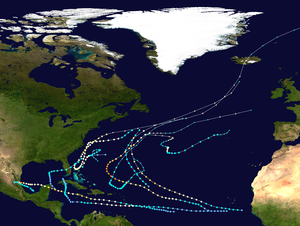| 1951 Atlantic hurricane season | |
|---|---|
 Season summary map | |
| Seasonal boundaries | |
| First system formed | January 4, 1951 |
| Last system dissipated | December 11, 1951 |
| Strongest storm | |
| Name | Easy |
| • Maximum winds | 150 mph (240 km/h) (1-minute sustained) |
| • Lowest pressure | 937 mbar (hPa; 27.67 inHg) |
| Seasonal statistics | |
| Total depressions | 17 |
| Total storms | 12 |
| Hurricanes | 8 |
| Major hurricanes (Cat. 3+) | 3 |
| Total fatalities | 276+ overall |
| Total damage | $80 million (1951 USD) |
| Related articles | |
The 1951 Atlantic hurricane season was the first hurricane season in which tropical cyclones were officially named by the United States Weather Bureau.[1] The season officially started on June 15, when the United States Weather Bureau began its daily monitoring for tropical cyclone activity;[2] the season officially ended on November 15.[3] It was the first year since 1937 in which no hurricanes made landfall on the United States;[4] as Hurricane How was the only tropical storm to hit the nation, the season had the least tropical cyclone damage in the United States since the 1939 season.[5] As in the 1950 season, names from the Joint Army/Navy Phonetic Alphabet were used to name storms this season.[6]
The first hurricane of the season, Able, formed prior to the official start of the season; before reanalysis in 2015, it was once listed as the earliest major hurricane on record in the Atlantic basin. It formed on May 16 and executed a counterclockwise loop over the Bahamas; later it brushed the North Carolina coastline. Hurricane Charlie was a powerful Category 4 hurricane that struck Jamaica as a major hurricane, killing hundreds and becoming the worst disaster in over 50 years. The hurricane later struck Mexico twice as a major hurricane, producing deadly flooding outside of Tampico, Tamaulipas. The strongest hurricane, Easy, spent its duration over the open Atlantic Ocean, briefly threatening Bermuda, and was formerly listed as one of a relatively few Category 5 hurricanes on record over the Atlantic Ocean. It briefly neared Category 5 status and interacted with Hurricane Fox, marking the first known instance of a hurricane affecting another's path.
- ^ Neal Dorst (October 23, 2012). "They Called the Wind Mahina: The History of Naming Cyclones". Hurricane Research Division, Atlantic Oceanographic and Meteorological Laboratory. National Oceanic and Atmospheric Administration. p. Slides 62–72.
- ^ Staff Writer (1951-06-15). "Hurricane Warning System to Begin Tonight". The News and Courier. Retrieved 2011-01-09.[permanent dead link]
- ^ Staff Writer (1951-11-15). "Hurricane Season Ends, Said Mildest". The Victoria Advocate. Retrieved 2011-01-09.
- ^ Landsea, Chris; Anderson, Craig; Bredemeyer, William; et al. (January 2022). Continental United States Hurricanes (Detailed Description). Re-Analysis Project (Report). Miami, Florida: Atlantic Oceanographic and Meteorological Laboratory, Hurricane Research Division. Retrieved November 26, 2024.
- ^ Cite error: The named reference
mwrwas invoked but never defined (see the help page). - ^ Chris Landsea (2007). "Subject: B1) How are tropical cyclones named?". Hurricane Research Division. Archived from the original on 27 May 2010. Retrieved 2010-04-26.